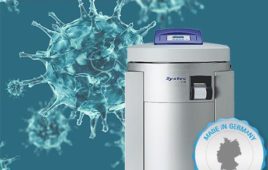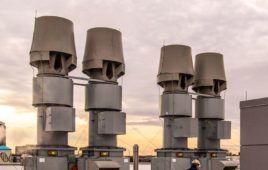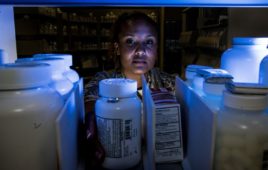Q: Auditors have requested test data to confirm that wipers used by a cleanroom consumables distributor are non-linting. Is this a requirement of USP 797?
A: Yes. The 2008 revision bulletin of The United States Pharmacopeial (USP) Convention states: “All cleaning materials, such as wipers, sponges, and mops shall be nonshedding, preferably composed of synthetic micro fibers, and dedicated to use in the buffer or clean area, ante-area, and segregated compounding areas and shall not be removed from these areas except for disposal.” The auditors were requiring validation documentation that the wipers in use were “non-shedding” or non-linting. The documented evidence is the particle contamination level data generated by the wiper manufacturer that is entered on the Certificate of Analysis accompanying each lot of wipers manufactured.
It should be noted that there is no recognized test, procedure, or recommended practice that can be performed to determine the correct wiper for a particular cleanroom, process, or activity. The final choice rests with the user in this determination. A wiper may be chosen because of its unique performance properties like the heat resistance found in cotton wipers, but if the wiper is used in an ISO Class 3 cleanroom, a wiper with such a high contamination level would likely not be found.
 Wiper selection is based on many factors. The wiper contamination characteristics may be determined as described in the IEST recommended practice, IEST-RP-CC004.3, Evaluating Wiping Materials Used in Cleanrooms and Other Controlled Environments. These contamination characteristic factors are the particle and fiber, non-speciated extractable matter and ionic contaminant contamination levels. Other factors, which may be more elusive to quantify, are the users’ process needs, the impact of the activities (e.g., cleaning spills and surfaces or holding manufactured parts or pieces) in the cleanroom, and the impact to product yield and manufacturing costs. These factors affect the type of wiper needed to achieve appropriate cleaning and contamination control. During the cleaning validation, all of the wiper characteristics are evaluated using the selected cleaning agent for the surfaces to be cleaned while normal cleanroom activities are performed. Pre-saturated wipers can be purchased with selected cleaning agents. It is important that the bulk of the cleaning agent liquid remains within the wiper so as to minimize the contamination of the cleanroom from the cleaning agent and not to cross-contaminate the cleaned areas during the cleaning process.
Wiper selection is based on many factors. The wiper contamination characteristics may be determined as described in the IEST recommended practice, IEST-RP-CC004.3, Evaluating Wiping Materials Used in Cleanrooms and Other Controlled Environments. These contamination characteristic factors are the particle and fiber, non-speciated extractable matter and ionic contaminant contamination levels. Other factors, which may be more elusive to quantify, are the users’ process needs, the impact of the activities (e.g., cleaning spills and surfaces or holding manufactured parts or pieces) in the cleanroom, and the impact to product yield and manufacturing costs. These factors affect the type of wiper needed to achieve appropriate cleaning and contamination control. During the cleaning validation, all of the wiper characteristics are evaluated using the selected cleaning agent for the surfaces to be cleaned while normal cleanroom activities are performed. Pre-saturated wipers can be purchased with selected cleaning agents. It is important that the bulk of the cleaning agent liquid remains within the wiper so as to minimize the contamination of the cleanroom from the cleaning agent and not to cross-contaminate the cleaned areas during the cleaning process.
Wipers used in ISO Class 3-5 cleanrooms are typically a knit polyester wiper with edges that are most likely sealed but may be cut if the durability process allows it. Wipers used in ISO Class 5-8 are typically a nonwoven polyester/cellulose wiper.
Previously, the contamination characteristics were described as affecting the wiper selection process. The performance characteristics, like the sorption capacity or rate, also impact the wiper selection decision. The sorption capacity of the wiper is the amount of liquid the wiper can hold. The sorption rate describes how fast a wiper can sorb that liquid. Other physical factors such as the appearance, hand (feel), or its drape (floppy or stiff) may affect the wiper decision.
Maintaining a cleanroom’s cleanliness level is an important but thankless job; however, it is critical to its continued function and use. Part of cleanroom maintenance is cleaning. Wiper-based cleaning is one of the most effective methods of cleaning. To achieve effective cleaning, appropriate wiping techniques are essential. Cleanroom wiping procedures are typically established in standard operating procedures (SOPs) that are site specific and based on cleanroom industry, e.g., microelectronics or life science; types of surfaces, e.g., rough or smooth; type of contamination; cleaning agents; and safety. Part of the cleaning process may require the use of swabs for small, hard-to-reach locations. Large surfaces are best handled by using mops. Both of these pieces of equipment could be considered, by analogy, wipers of different sizes on a stick.
For the most effective use of a wiper, several surfaces can be made through folding. For example, a 12 x 12” wiper can be folded into quarters. This folding will create up to eight surfaces available for wiping. The smaller wiper surface size allows better contact with the surface to be wiped and a more efficient use of the wiper. How to quarter-fold a wiper is demonstrated in Figure 1.
For the most effective cleaning process, wipe in one direction using parallel, overlapping strokes starting from the cleanest area and wiping towards the least clean area. It is important to use a fresh wiper surface for each cleaning stroke. A demonstration of how to wipe a surface is shown in Figure 2. When all eight surface areas have been used in the wiping process, the wiper is disposed according to the site SOP. This general wiping technique may be used in all classified cleanrooms and controlled environments and surfaces that are accessible to wiping.
 There are many types of wipers manufactured throughout the world. Currently, the Institute of Environmental Sciences and Technology (IEST)’s Working Group 4, of the IEST Contamination Control Division, is updating (to version four) the recommended practice, Evaluating Wiping Materials Used in Cleanrooms and Other Controlled Environments. This working group is comprised of wiper manufacturer industry experts, cleanroom consumable distributors, and end-users of wipers. Part of this revision is dedicated to the standardization of the test methods used to evaluate wipers. The robustness of the particle and fiber test method is being confirmed for both non-woven and knitted wipers through round-robin testing conducted in the wiper manufacturers’ Quality Control laboratories and an independent testing laboratory. Typically, a synthetic knit wiper is relatively clean. The characterization of its particle and fiber contamination level produces repeatable test results. Characterizing non-woven wipers, because of the higher particle and fiber contamination levels, is more challenging.
There are many types of wipers manufactured throughout the world. Currently, the Institute of Environmental Sciences and Technology (IEST)’s Working Group 4, of the IEST Contamination Control Division, is updating (to version four) the recommended practice, Evaluating Wiping Materials Used in Cleanrooms and Other Controlled Environments. This working group is comprised of wiper manufacturer industry experts, cleanroom consumable distributors, and end-users of wipers. Part of this revision is dedicated to the standardization of the test methods used to evaluate wipers. The robustness of the particle and fiber test method is being confirmed for both non-woven and knitted wipers through round-robin testing conducted in the wiper manufacturers’ Quality Control laboratories and an independent testing laboratory. Typically, a synthetic knit wiper is relatively clean. The characterization of its particle and fiber contamination level produces repeatable test results. Characterizing non-woven wipers, because of the higher particle and fiber contamination levels, is more challenging.
This working group is in the process of creating a definition for “low-linting” wipers to clarify that “non-linting” wipers are a misnomer. The working definition of “low-linting” proposed in this revision is, “Exhibiting few, if any, fibers or other contamination, visible without magnification, which can separate from, or easily be removed from material in a dry condition.” Typically, a wet wiper sheds less particles and fibers — that is, is less linting — than a dry wiper.
The IEST expects that this fourth revision will be published later in 2015.
The author would like to acknowledge and thank Dr. Jay Postlewaite, Senior Technical Advisor, ITW Texwipe, Kernersville, N.C. for his review and contribution to this article. Photos are courtesy of ITW Texwipe.
Jan Eudy is a Cleanroom/Contamination Control Consultant as well as a Fellow and Past President, Institute of Environmental Sciences and Technology. She is located in Carolina Beach, N.C. and can be reached at [email protected].
This article appeared in the May/June 2015 issue of Controlled Environments.



